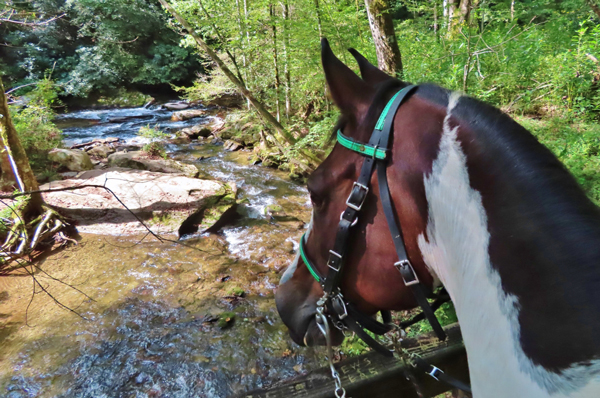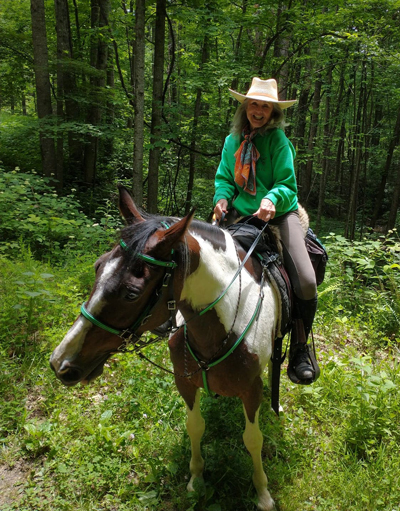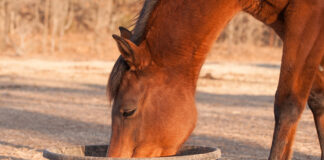
On August 12, 2017, Trina Ockenfels and her horse Tiger went on an average trail ride with a group of friends in Ionia State Recreation Area, which spans 4,500 acres. Unfortunately, their normal trail ride ended in tragedy when Tiger panicked due to some ground bees, threw Ockenfels off, and fled the scene. Tiger appeared to be in a frenzy, trying to get something off his foot before taking off. Despite long searches, both on the ground and in the air, Tiger’s remains weren’t found until almost four years later.
Preventing a Loose Horse Situation

Deirdre Perot, officer and volunteer for Back Country Horsemen of North Carolina, Pisgah Chapter, serves on BCHA’s Public Lands Committee and has miles of trail experience. She offers a few tips for riders before taking your horse trail riding.
First, spend time on desensitizing your horse. This allows your horse to begin to expect the unexpected, as well as builds a bond and trust with his rider. Perot also encourages riders to know the terrain and area before venturing out, including knowing the rules of the area.
Choosing who to trail ride with is also just as important, according to Perot, as it creates the vibe and energy of the ride; you want to keep your horse calm and relaxed. Perot suggests letting the horses graze every hour. This will create a habit for the horse, and if he run offs, then he is more likely to find the next grassy spot and stop to eat.
What to Do and What to Avoid
Riders should always know the phone number of the agency of the area where they plan to ride. Every rider on the trail that day should save it in their phone, as this should be the first call should your horse run off. This is crucial because if someone spots a loose horse and calls the agency, then staff are already aware of the situation and can reconnect rider and horse quicker.
In addition, pin a few phone numbers on the saddle in case a passerby comes across a loose horse. This way they can connect with the owner, or a friend, to return the horse.
All riders should remain calm as it is not the time for Wild West antics, as Perot says. Riders should not try to chase down the horse, as this could make him run more. Instead, simply walk down the trail after the loose horse.
However, if a search party is needed, Perot believes the cost of the search party for a loose horse will fall on the rider.
Train Your Horse to Stay Put
Van Hargis, western horsemanship clinician and horse trainer in Victoria, Texas, discusses the possibility of training a horse not to run away should a rider fall off. He feels that it comes down to the situation and the reason why the horse ran off. Always remember that the horse is a prey animal and will react on self-preservation first. When a horse faces a discomfort, for the sake of survival, he will likely flee.
Hargis questions how fair is it to ask a horse to stop when a predator is coming after him or if he is experiencing pain, such as being stung after riding into a beehive. Some training might kick in when the danger is gone, and the horse could stop fleeing. Training a horse to come back could be an option, but it depends on how far the horse fled.
Ground tying is a start and could be helpful in a loose horse situation, says Hargis. As a rider, you are providing the motivation to a horse for him to move (e.g., through the squeezing of your legs) and when you come off, there shouldn’t be any motivation for continued movement. By being the motivation for movement, you are then spending the time as an active rider instead of just being a passenger. Teaching your horse to stop as you are partly dislodged could also be beneficial to avoid a loose trail horse.
Tracking Devices for On the TrailTracking devices could be a great way to ensure that your horse is found. There are a few of different trackers on the market that could be used if you lose your horse while on the trails which can be attached on the saddle or bridle. Perot recommends a brand called Spot, which makes satellite messengers that her friends use. Spot will allow you to track assets, send and receive messages, share your GPS position and status as well as map and notify search and rescue officials if need be. For more information, visit www.findmespot.com. Another tracking device company is Minifinder, who has a tracker specifically for horses, and also for dogs and cats. A few advantages are that it is waterproof, will allow an owner to see the animal’s movement patterns on a map and listen to the area where he is located. This can be especially useful if the horse is near a road, for example. Learn more at www.minifinder.com. |







Thanks for your information